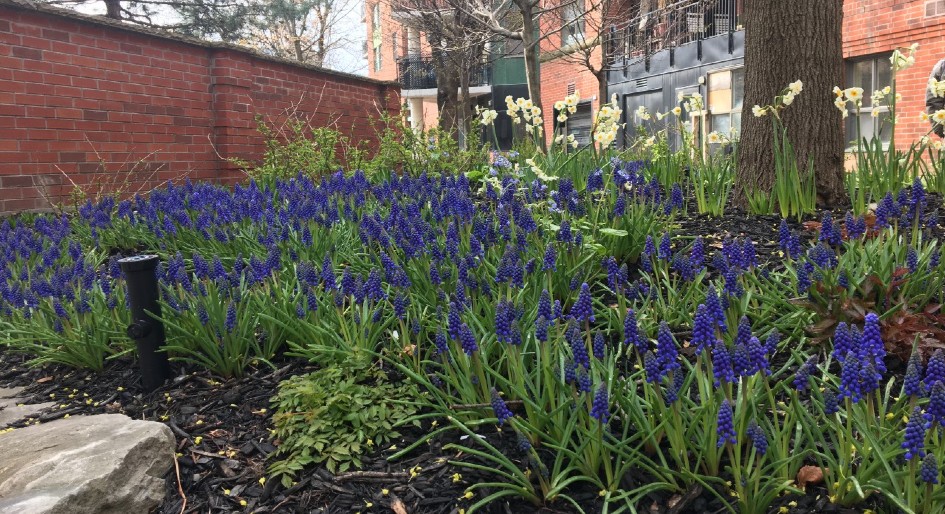Most GTA condominium grounds lack planted interest, texture and colour in the month of April and into early May. Most perennials don’t begin to show any interest until late May, with shrubs only sporadically prior to that.
Boards often become frustrated with this lack of early spring impact and, as a result, engage in a frenzy of pansy planting in the containers on either side of the main entrance. This approach leaves the balance of the landscape palette sorely in need of more—that extra touch that can enliven a condo property, while leaving its neighbours behind in the desolation of a post-winter state.
The ubiquitous pansy, like any other annual, can amount to a big-ticket item that bears little or no return on investment. They have to be planted every year and torn out by mid-July due to their lack of heat tolerance, leaving behind gaps in the landscape that have to be filled in a hurry.
The solution? Fall-planted bulbs. Usually what comes to mind for most when they hear these words are tulips—those keepers of the May time festivals such as the Canadian Tulip Festival held in Ottawa each year.
Despite their grand performance and eye-catching and massive colour displays, these varieties of tulips are usually trashed immediately after they are spent blooming in condo yards. New bulbs are planted again the following fall. The repeat cost is a sore point reality; if left in the ground, they would only partially re-bloom the following year and less so the next year, leaving only masses of floppy vegetable-looking foliage behind until early July—not an effective long-term, low-maintenance or cost-effective solution for the average condominium manager seeking to achieve both.
With a bit of research, however, and a great landscape design, a plethora of alternate fall-planted bulbs can be found. These bulbs should always abide by three crucial characteristics.
Perennialization
This is a term for fall bulbs that will not only return the following year, but will send out little off-springs known as bulblets. This not only increases the number of bulbs for future beauty, but also strengthens and enhances the performance of the original parent bulbs.
Tidy and Compact Habit
Nothing looks worse than a tall tulip, daffodil or narcissus that has flopped over once blooming starts. Tighter growing varieties are not only less likely to fall over; they are less prone to damage by pets or sports as their foliage and flowers can withstand some foot traffic.
Early Season Bloom Time
Nothing lifts winter doldrums like colour in the landscape when it is least expected in late March and early April. Such bulb varieties also provide a six-week jump ahead of the schedule of the common tulip and daffodil.
Favourites From Our Short List
Very Early Bloomers
Iris Reticulata ‘Harmony’- Dwarf Iris: Very early bloom time, as early as late March, depending on the site and will multiply over the years to produce more and more blooms.
Galanthus ‘Elwesii’ – Snowdrops: As the name implies, these very hardy and long-lasting white blooms often flower through the snow.
Snow Crocus ‘Ruby Giant’ – Snow Crocus: As the name implies, these are a well-known harbinger of spring and like their other March and April blooming siblings are effective in large drifts at the base of trees.
Early Bloomers
Tulipa ‘Dasystemon Tarda’: Tulipa ‘Puchella Eastern Star’ and Tulipa ‘Saxatilis’ – Botanical Tulips: While the typical May blooming tulips have the liabilities of flopping foliage and dwindling bloom-ability from year to year, botanical tulips multiply (naturalize) over time, have a low and tidy growth habit and an array of colours. The three noted here are great choices for the condominium landscape as they appear tough against the effects of dogs, rabbits and other sources of damage that can occur within the common elements.
Narcissi ‘Thalia’- Thalia Narcissus: We are all familiar with daffodils and narcissus, which come into their own in time for the Canadian Cancer Society’s spring fundraising drive. In the landscape, they pose one central challenge: they will multiply over time, but only if the foliage is left in place once the flowers have finished. For some, this provides a visual problem as that foliage must wither completely before being removed and, in most cases, that occurs no earlier than Canada Day. Thalia narcissus has narrow almost grass-like foliage that is short and more pleasing to have around after its pure white fragrant flowers have finished their show.
Later Bloomers
Allium ‘Globemaster’- Ornamental Allium: Beginning in May and into early June, there is no better show stopper on condo grounds than alliums. These are members of the onion family and sport perfect purple spheres 8 inches to 10 inches across and appear to float in the landscape. They are a must-have if you want your property to make an impression.
Plugging fall-planted bulbs into the right bed and the right design will illuminate them to their fullest and brightest potential in the spring landscape.
Kent Ford is founder of KFDG Inc., a Toronto-based Landscape Design and Project Management Firm www.kentforddesign.com. He can be reached at 416-368-7175 or kent@kentforddesign.com
Photo by KFDG Inc: Bulbs were incorporated into the planting design and installation at 801 King Street West (Citysphere Condominiums) in Toronto. There are benefits to planting the bulbs in large groups or drifts to maximize visual impact and create the illusion of a forest floor alive with spring colour and interest.



